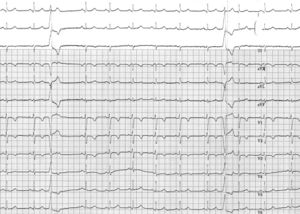Wide Complexes Intervening Regular Sinus Rhythm - 2: Difference between revisions
Jump to navigation
Jump to search
mNo edit summary |
mNo edit summary |
||
| Line 18: | Line 18: | ||
[[Puzzle_2007_1_33_Answer|Answer]] | [[Puzzle_2007_1_33_Answer|Answer]] | ||
[[Image:Puzzle_2007_1_33_fig2.png|Figure 2|thumb]] | [[Image:Puzzle_2007_1_33_fig2.png|Figure 2|thumb]] | ||
Revision as of 19:31, 8 October 2007
| Author(s) | A.A.M. Wilde | |
| NHJ edition: | 2007:01,033 | |
| These Rhythm Puzzles have been published in the Netherlands Heart Journal and are reproduced here under the prevailing creative commons license with permission from the publisher, Bohn Stafleu Van Loghum. | ||
| The ECG can be enlarged twice by clicking on the image and it's first enlargement | ||
A 38-year-old male patient presents with palpitations. He is not suffering from syncope or dizziness and has no other complaints. The family history bears no peculiarities. Physical examination of the heart reveals an irregular heart beat. Auscultation is normal and there are no signs of left or right heart failure. The ECG is depicted in figure 1.
What is your diagnosis and should there be any further investigation?

